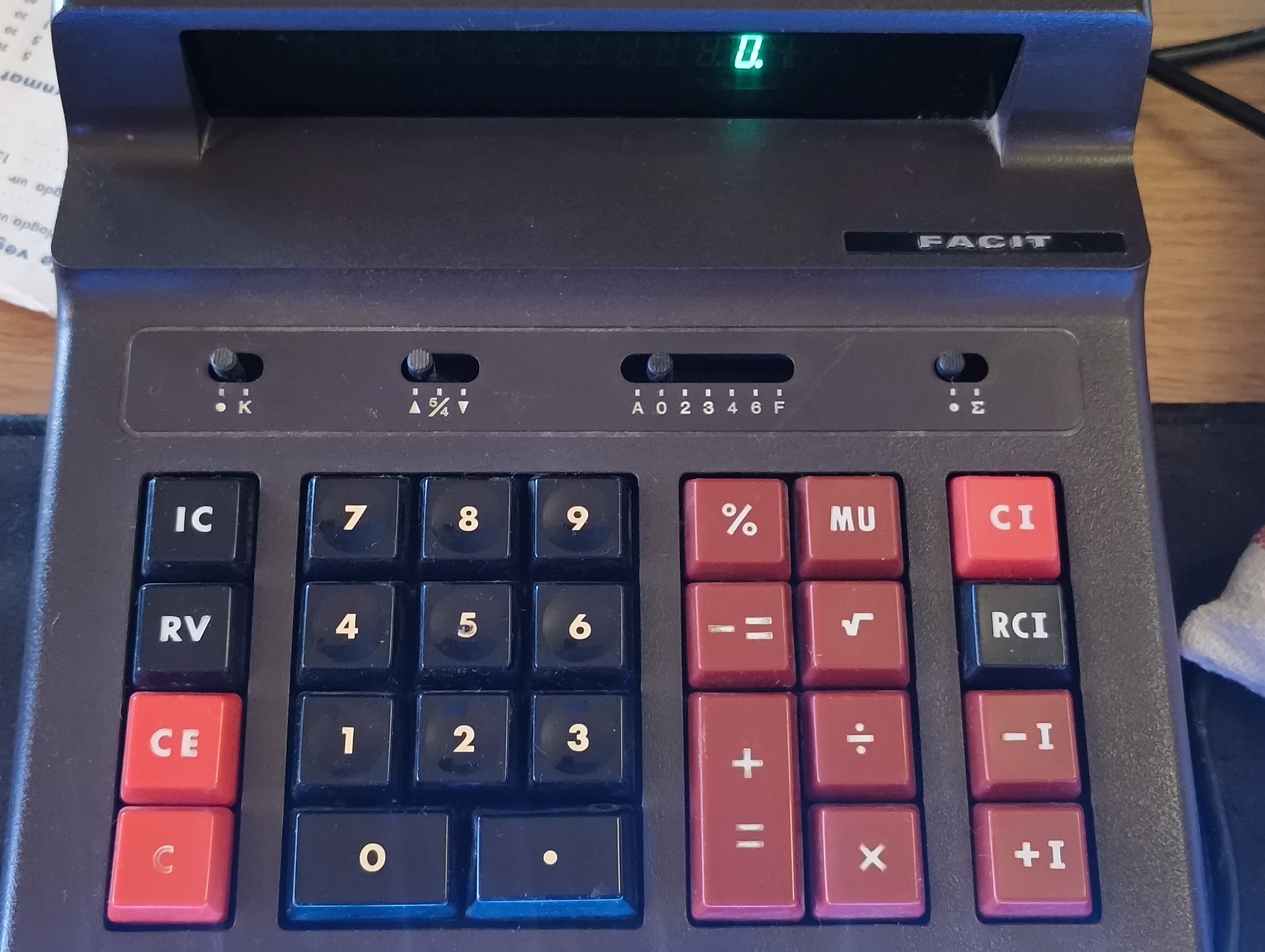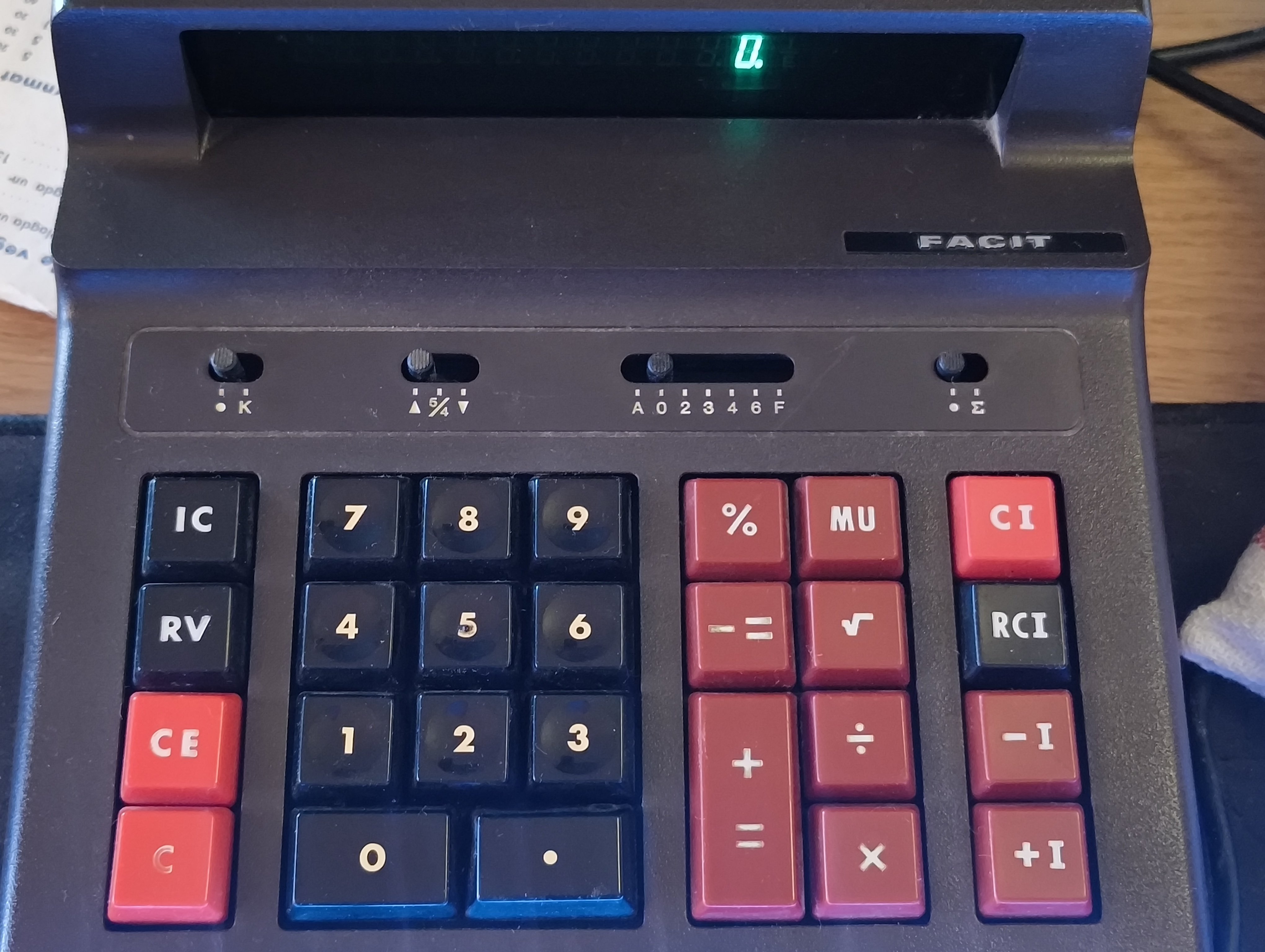Ok, some nerd please explain the switches on this IRL calculator app
-
This post did not contain any content.
-
This post did not contain any content.
I see a lot of wrong info on the the decimal slider. This is how it works:
A is for "Add-mode". This means that 2 decimals are always assumed. It's used for adding a lot of 2 decimal numbers, because you'll never have to press the decimal key.
If you've ever worked a credit card terminal and having to enter 200 to get 2.00$, that's how this setting works.0-6 are fixed and rounded according to the rounding setting.
The decimal F is for floating. It'll use the most relevant amount of decimals.
Another funny button is MU which is Mark Up. It's used with the percentage button. It's a backward ass way to do percentages. You'll enter a value and then MU the percentage that you want from the result, instead of the input.
Say you have product that costs 100 and you'll want to mark it up, so you'll get 20% of your new sales price as profit. Press 100 MU 20% and it should show 125, which is your sales price, because 25 is the 20% of 125.
It doesn't make sense to me why anyone ever needed that button. -
I see a lot of wrong info on the the decimal slider. This is how it works:
A is for "Add-mode". This means that 2 decimals are always assumed. It's used for adding a lot of 2 decimal numbers, because you'll never have to press the decimal key.
If you've ever worked a credit card terminal and having to enter 200 to get 2.00$, that's how this setting works.0-6 are fixed and rounded according to the rounding setting.
The decimal F is for floating. It'll use the most relevant amount of decimals.
Another funny button is MU which is Mark Up. It's used with the percentage button. It's a backward ass way to do percentages. You'll enter a value and then MU the percentage that you want from the result, instead of the input.
Say you have product that costs 100 and you'll want to mark it up, so you'll get 20% of your new sales price as profit. Press 100 MU 20% and it should show 125, which is your sales price, because 25 is the 20% of 125.
It doesn't make sense to me why anyone ever needed that button.Actually I found
this site (in German) which says that the MU is for Impact Calculation. Which... I wouldn't even begin to try to understand how I'd use. -
Actually I found
this site (in German) which says that the MU is for Impact Calculation. Which... I wouldn't even begin to try to understand how I'd use.According to that site, it also has an item counter. Normally this also on the print, but without a printer I guess it needs a button for that. Perhaps the IC button?
Remember that on desktop calculators the operations are entered reverse of ordinary pocket calculators. First you press the number and then you press the operation.
So to do 100 - 50 you need to press "100 + 50 -"Same for the MU. First you need a number to be added. Then MU some number as percentage and +=.
-
According to that site, it also has an item counter. Normally this also on the print, but without a printer I guess it needs a button for that. Perhaps the IC button?
Remember that on desktop calculators the operations are entered reverse of ordinary pocket calculators. First you press the number and then you press the operation.
So to do 100 - 50 you need to press "100 + 50 -"Same for the MU. First you need a number to be added. Then MU some number as percentage and +=.
If I switch the power on, and press the IC key nothing happens. But I do, as far as I can see, any calculation and press IC I get a (to me) random number displayed on screen. So yeah, that might be the case but I'm not sure what items it is counting. The RV key seems to flip between different numbers.
Impact Calculation might just be a mistranslation. DeepL seems to think it should be mark-up. Following what you told me, I still get no result from operating the calculator with MU and %. Which is surprising me because it acts like those keys have no function.
I'll write it in the order I press the keys and maybe you'll figure out what I'm doing wrong.
Switch on > 100 > MU > 20 > % = 20
It displays 20 even if I press += after. The display does update, so it is registering the key presses at least.
¯\_(ツ)_/¯
edit: ok I think I figured it out. It's MU > 100 > X > 20 > % > += > 120
-
If I switch the power on, and press the IC key nothing happens. But I do, as far as I can see, any calculation and press IC I get a (to me) random number displayed on screen. So yeah, that might be the case but I'm not sure what items it is counting. The RV key seems to flip between different numbers.
Impact Calculation might just be a mistranslation. DeepL seems to think it should be mark-up. Following what you told me, I still get no result from operating the calculator with MU and %. Which is surprising me because it acts like those keys have no function.
I'll write it in the order I press the keys and maybe you'll figure out what I'm doing wrong.
Switch on > 100 > MU > 20 > % = 20
It displays 20 even if I press += after. The display does update, so it is registering the key presses at least.
¯\_(ツ)_/¯
edit: ok I think I figured it out. It's MU > 100 > X > 20 > % > += > 120
It think you should try:
100 > + > MU > 20 > % > +=
It should show 125.
-
It think you should try:
100 > + > MU > 20 > % > +=
It should show 125.
That shows 120.
-
That shows 120.
Hmm. I guess different brands do this stuff differently.
In real life I'd definitely prefer to break the equation into separate operations, just to ensure that I understand and can document the process. -
Hmm. I guess different brands do this stuff differently.
In real life I'd definitely prefer to break the equation into separate operations, just to ensure that I understand and can document the process.I guess that's why I don't know what I'm looking at. I've not had great math teachers through my school time, and I don't actually know what this is supposed to do. Like, in actual math steps.
I see that the result should be 125. Why ain't it 120?
-
I guess that's why I don't know what I'm looking at. I've not had great math teachers through my school time, and I don't actually know what this is supposed to do. Like, in actual math steps.
I see that the result should be 125. Why ain't it 120?
It's supposedly used for gross profit margin calculations, which is an equation for business stuff rather than an ordinary math function. It adds a profit of a margin calculated from the gross price. The gross price is unknown, so you'd input the net price and the desired margin of the result.
Ordinary percentages would be used for "net margin": net price + percentage of net price = gross price.
This can be done by simple multiplication, such as: 100 x 1.2 = 120This does "gross margin": net price + percentage of gross price = gross price.
This would require solving an equation in several steps to do:
100 / ( 1 - 0.20) = 125It might seem like a rather random function to add to a calculator, but it has to be seen in the context of being prior to computer spread sheets, where accountants would make price lists of hundreds of products manually, so a short cut like this could save a lot of time.
-
It's supposedly used for gross profit margin calculations, which is an equation for business stuff rather than an ordinary math function. It adds a profit of a margin calculated from the gross price. The gross price is unknown, so you'd input the net price and the desired margin of the result.
Ordinary percentages would be used for "net margin": net price + percentage of net price = gross price.
This can be done by simple multiplication, such as: 100 x 1.2 = 120This does "gross margin": net price + percentage of gross price = gross price.
This would require solving an equation in several steps to do:
100 / ( 1 - 0.20) = 125It might seem like a rather random function to add to a calculator, but it has to be seen in the context of being prior to computer spread sheets, where accountants would make price lists of hundreds of products manually, so a short cut like this could save a lot of time.
wrote on last edited by [email protected]Just hopping in to say that with the help of AI, I finally managed to figure out that the button shows the absolute difference between two numbers. The order of operations is 50 - 75 MU = 25.
Why it's marked MU is a mystery.
edit: actually, might be "marginalutfall" or "marginalutveckling".




